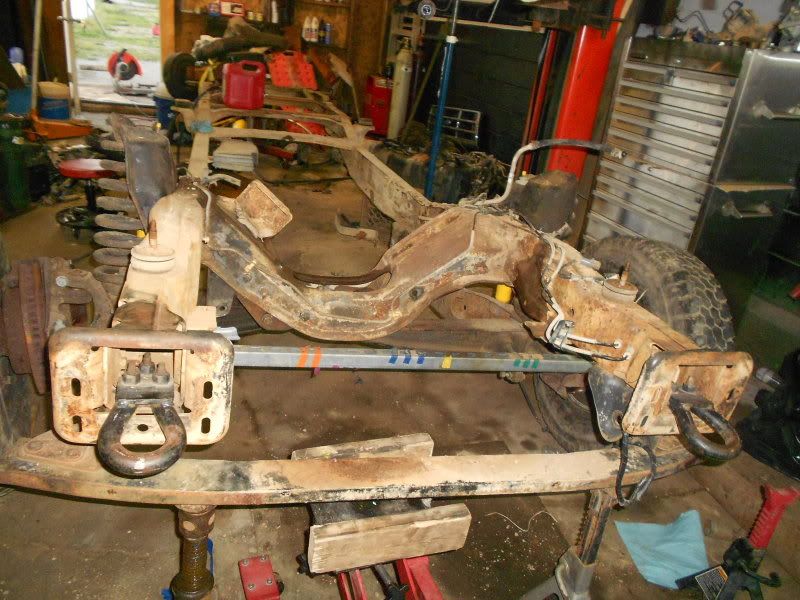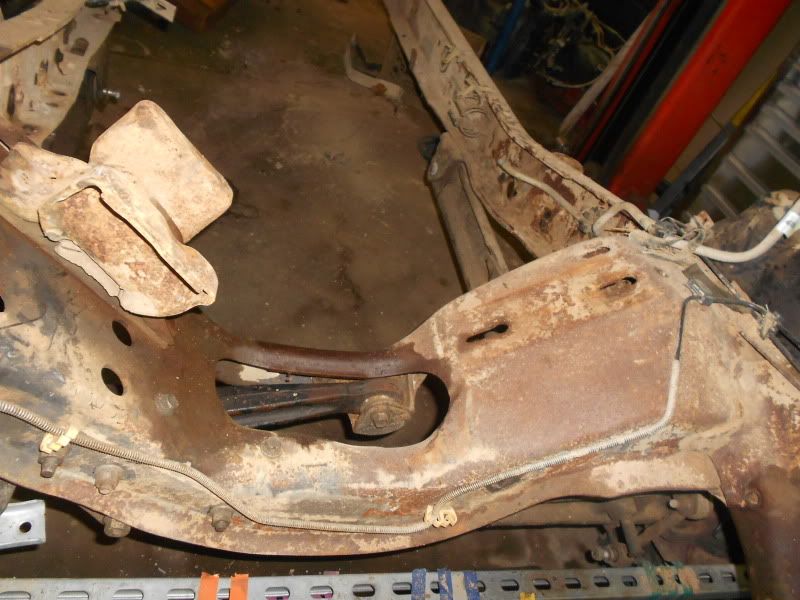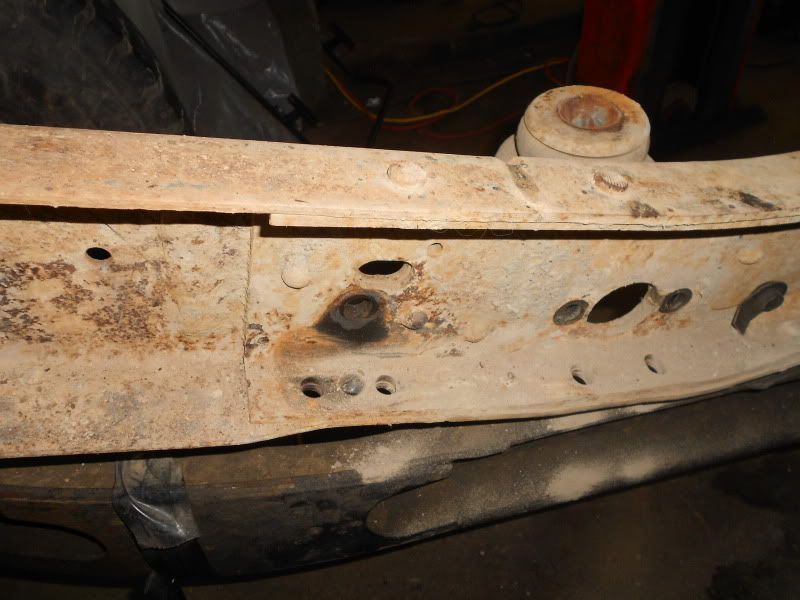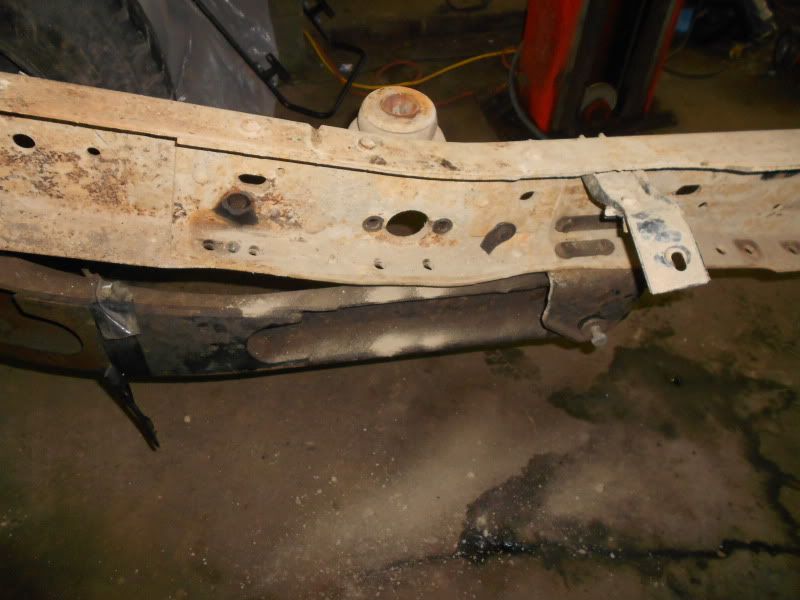are all cab chassis frames the same strength
#32
#33
i have both frames in my yard. How about you? Do you even own commercial cab chassis one??
seriously are you blind or on drugs ? You don't see that the front is exactly the same??
all frame channel without reinforcement is 7.5 inches. this is only up to 2007 becaus that's what i own.
I part these truck out left and right. How about you??
Here's a nice vid of f250 frame i'm working on today
<a href="http://s22.photobucket.com/albums/b341/mrblonde108/?action=view&current=DSCN0236.mp4" target="_blank"><img src="http://i22.photobucket.com/albums/b341/mrblonde108/th_DSCN0236.jpg" border="0" alt="Photobucket" style="width: 160px;"></a>
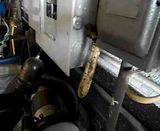
seriously are you blind or on drugs ? You don't see that the front is exactly the same??
all frame channel without reinforcement is 7.5 inches. this is only up to 2007 becaus that's what i own.
I part these truck out left and right. How about you??
Here's a nice vid of f250 frame i'm working on today
<a href="http://s22.photobucket.com/albums/b341/mrblonde108/?action=view&current=DSCN0236.mp4" target="_blank"><img src="http://i22.photobucket.com/albums/b341/mrblonde108/th_DSCN0236.jpg" border="0" alt="Photobucket" style="width: 160px;"></a>

#35
I think we are talking about seperate things, not frame cee width, not height, but material thickness. Caliper the material thickness behind the hook horn, along the rails, and in the reinforcement plate behind the front section. And yes, i own a 2002 F350 and a 2002 F550. I hope i did not offend you, but i am getting different results. With that, i hope there is sufficient information for people to formulate their own conclusions.
#36
A pick up is the same from the front bumper mounts to the first cab mount where it is riveted and welded on the pickup the tallest part of channel is 7 1/4 inches on the one in garage.
the cab chassis i have sitting out side has straight rails and it is 8 1/2" tall. the 2007 f550 frame i have is also 8 1/2 inches tall frame is same thickness. other than the riveted on reinforcement my 550 frame is the longest wheel base. 120" cab to axle.
only thing i know they changed is the steering boxes and the holes when they went to the coil spring set up. the 550 came with 2 different options for steering box. i don't know what difference is.
I also chopped up an old body style superduty it had the 120" cab to axle also and it had doube frame all the way up to spring perches. first time i saw double frame on older fsuperduty. Must have been the long wheelbase.
I didnt check reinforcement section on the f350 cab chassis yet. but that just an added reinforcement frame is still the same. It might be there because it narrow down to 34"
Is the f350 you own cab chassis or pick up? I just measure the 07 f550 and 01 f350 same exact thickness. These are Cc trucks.
the cab chassis i have sitting out side has straight rails and it is 8 1/2" tall. the 2007 f550 frame i have is also 8 1/2 inches tall frame is same thickness. other than the riveted on reinforcement my 550 frame is the longest wheel base. 120" cab to axle.
only thing i know they changed is the steering boxes and the holes when they went to the coil spring set up. the 550 came with 2 different options for steering box. i don't know what difference is.
I also chopped up an old body style superduty it had the 120" cab to axle also and it had doube frame all the way up to spring perches. first time i saw double frame on older fsuperduty. Must have been the long wheelbase.
I didnt check reinforcement section on the f350 cab chassis yet. but that just an added reinforcement frame is still the same. It might be there because it narrow down to 34"
Is the f350 you own cab chassis or pick up? I just measure the 07 f550 and 01 f350 same exact thickness. These are Cc trucks.
#37
#38
Wait a second, it is not possible, that the F-550 is the same frame as the F-350 just with doubled parts, because the base material thickness of the F-550 is around 8mm, which is more then the 6.5mm, according to both the pdf file AND ruschejjs own measurements!
Question was: Is the BOXED part also thicker or not, or didnt i get some of the postet stuff?
Because a 8mm boxed-frame sounds pretty extreme to mee too.
And again: anyone has anything about the material used on the frames?
Greetings
Question was: Is the BOXED part also thicker or not, or didnt i get some of the postet stuff?
Because a 8mm boxed-frame sounds pretty extreme to mee too.
And again: anyone has anything about the material used on the frames?
Greetings
#39
You are quite right. It is not possible that the F-550 frame is the same as the F-350 frame, in either chassis cab, dual rear wheel pickup, or single rear wheel pick up configurations.
So that we are comparing apples to apples, the part numbers and my comments below apply ONLY to 1999-2004 trucks with front leaf springs for 4x4 and the old style radius arms and coils for 4x2 F-350s (all 450/550's of that era had front leaf springs, whether 4x4 or 4x2).
In 1999, Ford's front frame rails more or less followed the datum line of the frame. In 2001, Ford added an after the fact designed "Blocker Beam" to provide a lower frame mounted collision point to prevent the truck from riding up over smaller cars in a collision, to meet a federal mandate.
In 2004 (for the 2005 model year) Ford, made a few subtle changes to the way this Blocker Beam was shaped and mounted, along with other changes to the front frames to accommodate the new style radius arm front suspension and steering system.
In 2007 (for the 2008 model year) Ford made more radical changes to the front frames, hydroforming a downard dip that lowered the frame horns by 7" to meet the collision compatibility requriements without any additional add on structure like the old "Blocker Beam".
For purposes of the frame comparison below, none of the frame design changes summarzied above are being considered , nor is any frame newer than 2003, simply because I have not owned nor have had any interest in a Superduty newer than 2003.
Some people in this thread have been comparing the frames from "cab back" or "back of cab". I think this is technically in error, because the ONLY frame sectional break in any 99-03 Ford Superduty frame occurs at the front of the cab, specifically at the firewall, approximately 4.5 feet back from the front bumper mounts. This is the only place were the frame is divided into two sections, to enable the main frame section (aft of this point) to be successfully saved by just replacing the front frame section (forward of this point) in the event of a frontal collision.
Since I keep talking about front collisions, let's just compare the front frame sections here, as it is this section that was mic'd for differences in material thickness with a dial caliper by an eariler contributer to this thread, and it is this section that also appears to be the most dimensionally similar across all models of Superduties being compared.
So let's all run our trucks into a wall. I'll start, and when I go to have my F-550 repaired, I see that the body shop will have to order front frame section F81Z-5C145-CA. To help in comparing my front frame section part number to anyone with a different truck who rams their truck into a wall, let's break this part number down:
The "basic" part number for front frame sections is the middle portion: "5C145". The prefix "F81Z" means it was finalized in 1998 ("F8") and it is a service part number from FCSD ("Z"), not the original engineering number. The most critical portion of this entire part number is the suffix, in this case "CA". This suffix is where we will see a differentiation between front frame section part numbers between the F-350 and F-550 chassis cabs.
So, to reiterate, the prefix and basic will be the same for all front frame sections, to wit: F81Z-5C145-___. The suffix will be the differentiating indicator. If the suffix is different, the part will be different.
Boom! An F-350 chassis cab just rammed into a wall. His front frame part number? "BA"
Bam! An F-350 crew cab DRW pickup just bashed the wall. His front frame part number? "AB" Notice the difference between chassis cab and non chassis cab.
Splat! An F-250 crew cab pickup just hit the wall. His front frame part number" "AB" Notice it is the same as the F-350 pick up, but not the same as either the F-350 chassis cab "BA", nor my F-550 "CA".
And of course notice that the F-550 chassis cab doesn't use the same replacement front frame secton part number as the F-350 chassis cab. (CA vs BA).
Yet, all of these frame sections look, to the naked eye, to be exactly the same between 1999 and 2003. In fact, this is the very reason why I specifically focused on the front frame sections, because this portion is the same from an outer overall dimensional standpoint, regardless of cab style, wheel base, cab axle distance, narrow 34" frame, wide 37" frame, straight rails, sleeved rails, contoured rails, etc. Those differences are more obvious. What was interesting to me is that which isn't obvious.
The front frame sections do look the same, yet we see that there are different part numbers. This part number information, coinciding with the differences measured in material thickness, would be sufficient evidence for me to order the part for the F-550 if I ever do run into a wall, and not get the part for the F-350 chassis cab, even though it looks the same.
So that we are comparing apples to apples, the part numbers and my comments below apply ONLY to 1999-2004 trucks with front leaf springs for 4x4 and the old style radius arms and coils for 4x2 F-350s (all 450/550's of that era had front leaf springs, whether 4x4 or 4x2).
In 1999, Ford's front frame rails more or less followed the datum line of the frame. In 2001, Ford added an after the fact designed "Blocker Beam" to provide a lower frame mounted collision point to prevent the truck from riding up over smaller cars in a collision, to meet a federal mandate.
In 2004 (for the 2005 model year) Ford, made a few subtle changes to the way this Blocker Beam was shaped and mounted, along with other changes to the front frames to accommodate the new style radius arm front suspension and steering system.
In 2007 (for the 2008 model year) Ford made more radical changes to the front frames, hydroforming a downard dip that lowered the frame horns by 7" to meet the collision compatibility requriements without any additional add on structure like the old "Blocker Beam".
For purposes of the frame comparison below, none of the frame design changes summarzied above are being considered , nor is any frame newer than 2003, simply because I have not owned nor have had any interest in a Superduty newer than 2003.
Some people in this thread have been comparing the frames from "cab back" or "back of cab". I think this is technically in error, because the ONLY frame sectional break in any 99-03 Ford Superduty frame occurs at the front of the cab, specifically at the firewall, approximately 4.5 feet back from the front bumper mounts. This is the only place were the frame is divided into two sections, to enable the main frame section (aft of this point) to be successfully saved by just replacing the front frame section (forward of this point) in the event of a frontal collision.
Since I keep talking about front collisions, let's just compare the front frame sections here, as it is this section that was mic'd for differences in material thickness with a dial caliper by an eariler contributer to this thread, and it is this section that also appears to be the most dimensionally similar across all models of Superduties being compared.
So let's all run our trucks into a wall. I'll start, and when I go to have my F-550 repaired, I see that the body shop will have to order front frame section F81Z-5C145-CA. To help in comparing my front frame section part number to anyone with a different truck who rams their truck into a wall, let's break this part number down:
The "basic" part number for front frame sections is the middle portion: "5C145". The prefix "F81Z" means it was finalized in 1998 ("F8") and it is a service part number from FCSD ("Z"), not the original engineering number. The most critical portion of this entire part number is the suffix, in this case "CA". This suffix is where we will see a differentiation between front frame section part numbers between the F-350 and F-550 chassis cabs.
So, to reiterate, the prefix and basic will be the same for all front frame sections, to wit: F81Z-5C145-___. The suffix will be the differentiating indicator. If the suffix is different, the part will be different.
Boom! An F-350 chassis cab just rammed into a wall. His front frame part number? "BA"
Bam! An F-350 crew cab DRW pickup just bashed the wall. His front frame part number? "AB" Notice the difference between chassis cab and non chassis cab.
Splat! An F-250 crew cab pickup just hit the wall. His front frame part number" "AB" Notice it is the same as the F-350 pick up, but not the same as either the F-350 chassis cab "BA", nor my F-550 "CA".
And of course notice that the F-550 chassis cab doesn't use the same replacement front frame secton part number as the F-350 chassis cab. (CA vs BA).
Yet, all of these frame sections look, to the naked eye, to be exactly the same between 1999 and 2003. In fact, this is the very reason why I specifically focused on the front frame sections, because this portion is the same from an outer overall dimensional standpoint, regardless of cab style, wheel base, cab axle distance, narrow 34" frame, wide 37" frame, straight rails, sleeved rails, contoured rails, etc. Those differences are more obvious. What was interesting to me is that which isn't obvious.
The front frame sections do look the same, yet we see that there are different part numbers. This part number information, coinciding with the differences measured in material thickness, would be sufficient evidence for me to order the part for the F-550 if I ever do run into a wall, and not get the part for the F-350 chassis cab, even though it looks the same.
#40
Thank you very much for this extremely detailed or to be more specific almost juristic abstract!
So the front part is definetly not the same, but like comadown measured, the only difference seems to be the material thickness.
Since this front part thickness seems to be the exact same as the base thickness of the F-550 open c back part i guess the inner part is also the same thickness? Or maybe the inner front part, or to be more specific the "boxing inlay??" so the second c-profile that makes the front end boxed is the same?
Is it possible that those crash regulations made the frame weaker when it comes to heavy loading or offroading abuse, because there is now a part of the frame which can not flex as well?
Or maybe this is why ford took good care to just box this hsort front part, where the torsionally stress is pretty small?
This could be interesting, since dodge has a way longer boxed front part: http://www.ebuild.com/ImgRepos%5C200...5%5C5_1000.jpg
also dodge seems to be in no need for doubling any part of the frame up to 0.600, even up to the 19.500 gvw, which i guess has something to do with that 50.000psi frame, or maybe the rails are just bigger in general, at least this middle part looks damn high, should be at least 12".
Greetings
So the front part is definetly not the same, but like comadown measured, the only difference seems to be the material thickness.
Since this front part thickness seems to be the exact same as the base thickness of the F-550 open c back part i guess the inner part is also the same thickness? Or maybe the inner front part, or to be more specific the "boxing inlay??" so the second c-profile that makes the front end boxed is the same?
Is it possible that those crash regulations made the frame weaker when it comes to heavy loading or offroading abuse, because there is now a part of the frame which can not flex as well?
Or maybe this is why ford took good care to just box this hsort front part, where the torsionally stress is pretty small?
This could be interesting, since dodge has a way longer boxed front part: http://www.ebuild.com/ImgRepos%5C200...5%5C5_1000.jpg
also dodge seems to be in no need for doubling any part of the frame up to 0.600, even up to the 19.500 gvw, which i guess has something to do with that 50.000psi frame, or maybe the rails are just bigger in general, at least this middle part looks damn high, should be at least 12".
Greetings
#41
Something i forgot:
Does the 4-corner Leaf spring-frame of the F-550 somehow differ to the new frame when it comes to the material dimensions or the height?
Comadown mentioned that the older fully-leaf-springed- f-550 had a gvw of "only" 17.950.
Did they use the boxed-open-c combination as well? if so when was the last complete-openc-f-550 and what kind of frame measurements did that one use? Was it just the same as the modern f-550 in the rear?
Greetings
Does the 4-corner Leaf spring-frame of the F-550 somehow differ to the new frame when it comes to the material dimensions or the height?
Comadown mentioned that the older fully-leaf-springed- f-550 had a gvw of "only" 17.950.
Did they use the boxed-open-c combination as well? if so when was the last complete-openc-f-550 and what kind of frame measurements did that one use? Was it just the same as the modern f-550 in the rear?
Greetings
#42
I made a picture that identifies and gives thicknesses of alot of the ford chassis cab and pickup frames from 1967 up to now if anyone is wanting to see it. I can email it...I may see if I can upload it to this page. Its a huge image. you have to zoom into it and scroll around to beable to read everything. I found some info on thickness from order guide books like someone else already posted. Alot of the stuff I went out and found out myself. If anyone wants to see it just ask me.
#44
Depends on which year, which wheelbase, and which rail section of the frame. But the main answer is no, there is no difference in material dimensions between over the years for the main (mid cab and aftward) section of the frame.
However, there is a difference in the front section of the frames, where the engine and front suspension are supported.
1. The model years 1999-2004 are the "4-corner leaf spring" front frames.
2. The model years 2005-2007 introduced front coil springs on both 2WD and 4WD versions, with a front frame section slightly modifed to accommodate the new suspension hardware as well as the newly available wide track front axle that decreased the turning radius by increasing the degree of wheel cut. The "Super 60" verision of this axle saw an increase in GVWR rating of 1,000 lbs.
3. The model years 2008-2010 introduced the lowered front frame horns, where the front section of the frame dipped downward forward of the front axle, in order to engage the frame with the average bumper beam heights of smaller cars.
Previously, Ford installed "Blocker Beams" of various iterations in order to meet the "impact friendly" FMVSS standard that was enacted after the original Super Duty frames were already in production. Ford's first compliance effort was the Blocker Beam.
Now, from 2008 forward, with the new lowered frame horns with a more radically bent down shape made possible by the adoption and advancement of hydro forming frame manufacturing, no more Blocker Beam was required.
In all three of the frame designs enumerated above, the front frame section was severable (a separate section) from the main frame. This was to enable the truck to be more easily and inexpensively salvaged from a front end collision by replacing only the front section of the frame.
The joint between front and rear sections of the frame is at the firewall.
The front frame differences and changes described above apply to all Ford Super Duties, not just F-550s.
Actually, both older and newer F-550s have a GVWR of even less than that... "only" 17,500 lbs to be exact. (Newer regular cab models have a standard GVWR of 18,000 lbs.)
And, both newer and older F-550's have always had an available option to increase the GVWR to 19,500 lbs, depending on the wheelbase and cab configuration that this is option was made available on, which has changed over the years.
The 19,500 lb. GVWR option was more restricted in earlier model years, and over time has expanded to encompass more wheel base and cab configurations. That is probably why the option appears to be a function of frame design change, rather than simply expanded availability.
For any given wheelbase and cab configuration, the rear main frames are the same material dimension between older and newer F-550s. For that matter, the frames are the same between 17,500 GVWR and 19,500 GVWR also. The increase in GVWR for the frames is accomplished via sleeving the original frame with "L" channel reinforcements.
These "L" channel reinforcments are riveted to the frame with the same rivets that retain the frame crossmembers, and they are unavailable separately, so they are not a reinforcement easily added after original manufacture. The "L" channel reinforcments are uniquely integrated into the frame in two opposing sections per rail side, with a diagonally oriented break between sections at the cab to bed joint area of the frame, where it needs to be the most flexible.
The "L" channel reinforcements substantially increase the section modulus of the original frame, from 10.1 (original) to 17.2 (with "L" channel), and they serve to nearly double the frame thickness from .320 to .600. These frame section modulus and thickness specifications hold true from as early as 1999 to as recently as 2012. There have been no changes in these regards.
Yes, open C in the main cab and bed frame sections, and yes, boxed frame in separate front section from firewall forward. This design is consistent throughout all production years of the F-550. And yes, the older F-550 (1999) is the same as the modern F-550 (2012) in the rear section of frame.
Keep in mind, there are some little differences between older and newer frames... ie, there are some holes that are no longer drilled in the web section above the axle, the axle bump stop mounting cleat is different (as the axle bump stop itself, as well as the axle, is different) etc.
But the same A36 36,000 psi yield strength, .320 wall thickness open C formed section of frame with the same flange depth, the same web height, and same cross member locations are consistent over the last dozen years the F-550 has been made.
Furthermore, the same increase in GVWR (to 19,500 lbs) has been accomplished via the same method throughout that period of time, with the addition of riveted "L" channel reinforcements both at the bed section as well as the under cab section of the main fraime rail.
In case you go looking for at frames, note that the "L" reinforcements are inverted from each other on either rail at the cab to bed junction, where the shorter flange part of the L laps over the top flange of the bed section of frame, and laps under the bottom flange of the cab section of frame.
In both cases, the longer web part of the L meets up against the outside (outboard) part of the web (vertical) portion of the frame.
The front sections of these frames were always boxed, even back in 1999. For that matter, even back in 1979, the very front sections of Ford truck frames have been boxed.
Hope this clears it up a bit.
#45
Would be absolutlely awesome! hendrickson360@gmail.com!


